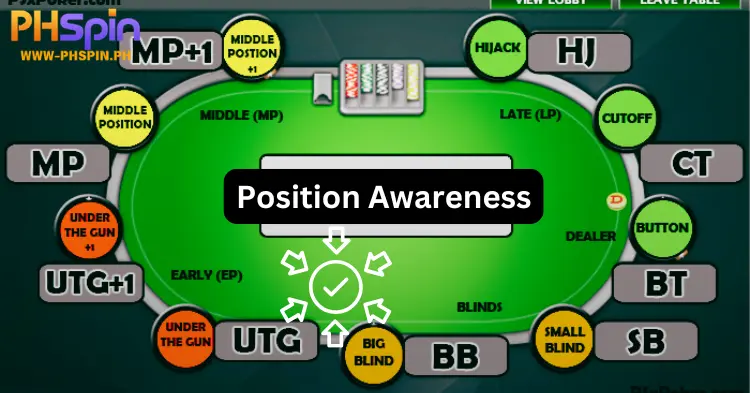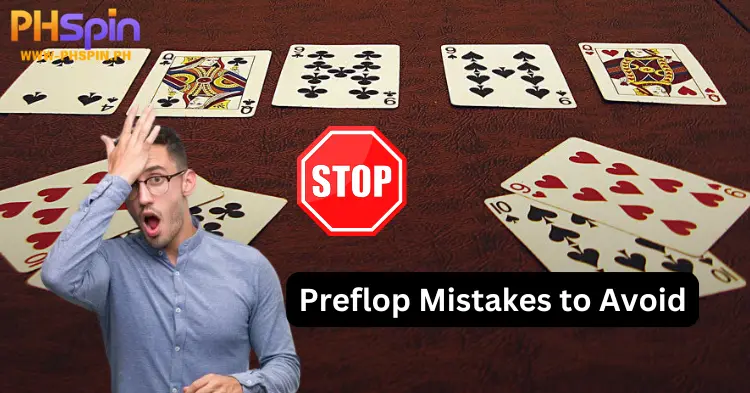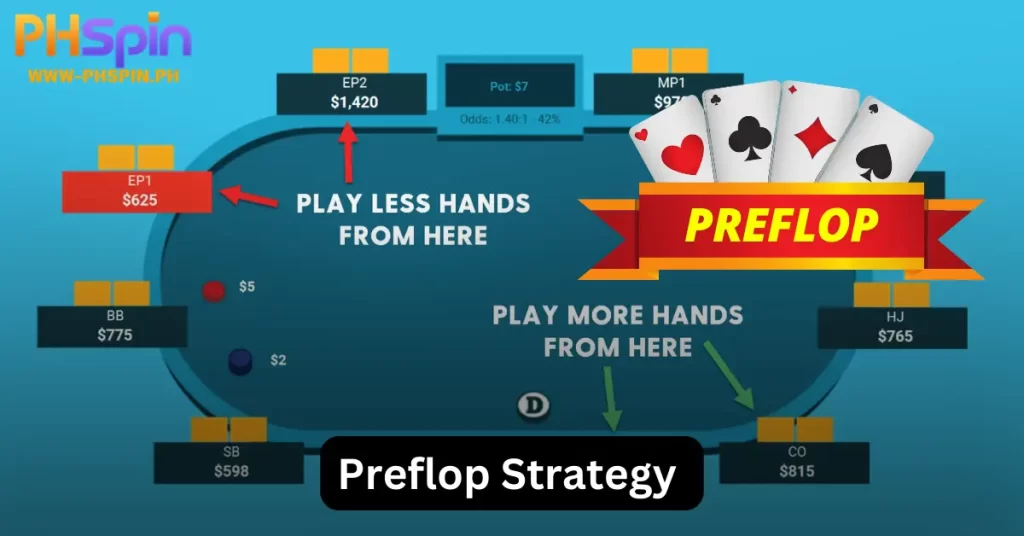Preflop Strategy in Poker is the foundational bedrock on which to construct a solid game in poker. Smart preflop decisions set the tone for the remainder of the hand and provide the potential to maximize profits with good hands and minimize losses with weaker ones.
In this article, PHSPIN touches on the key preflop strategy in poker and common mistakes that will further help you develop your game for the long haul.
Key elements of a strong preflop strategy in poker include
Position Awareness

Your table position is one of the most important considerations of a preflop strategy in poker. Players in later positions, like the cutoff or button, have additional information on which to base a decision because they get to see how others have acted. The early position players, like those on the small blind or UTG position, cannot be as speculative and therefore must be more conservative in their actions than others.
- Early Position (EP): Play strong, high-value hands such as pocket pairs (Aces, Kings, Queens) and suited connectors. Fold weaker hands since you are most likely to find raises or strong betting from later positions.
- Middle Position (MP): Open your range slightly with hands like A-Q, A-J suited, or 10-10. You will have some positional advantage over early players, but you still can’t get too excited.
- Late Position (LP): In late position, you can open up your hand selections. You can now include lower pairs, suited connectors, and weaker aces in your playbook and even bluff or steal the blinds if folds come from the earlier players.
Hand Selection
Success in the Preflop Strategy in poker involves knowing which hands to be in. You have to start in positions with stronger hands so that you will hold your edge and control the pot size.
- Premium Hands: A-A, K-K, Q-Q, A-K suited. Overall, you should be raising or re-raising in any position with these hands, occasionally laying back in an early position.
- Good Hands: Combinations like 10-10, 9-9, and suited connectors like the K-Q suited or Q-J suited make good bets, especially from middle to late position.
- Marginal Hands: Suited connectors or low pairs for instance, 5-5, 6-6 can be considered in late position if the action will let you. Again, don’t overplay these by early position.
Adapt Your Strategy to the Table
You will have to observe the moves that are used by your opponent and change accordingly. In case the table is tight, you might widen up to include some speculative hands, while if the table is loose, you’ll want to be tighter so that you don’t expose yourself to undue risks.
For players who want to enhance their adaptability, platforms like Jilibet provide insights and resources on situational strategies, helping you tailor your approach to maximize your advantage in any game environment.
- Aggressive Tables: In aggressive games, choose hands. Only call with strong cards in your hand, and be prepared to fold marginal hands early.
- Passive Tables: You can generally expand your range at passive tables, playing more drawing hands and medium pairs since you’ll often be allowed to get into a cheap flop.
Preflop Mistakes to Avoid

Recognizing and avoiding preflop pitfalls is essential for improving the preflop strategy in Poker. Here are some commonly committed mistakes by players:
- Too many hands: Overexposure to the range will only lead to a series of unfavorable postflop situations. The player must be disciplined enough to fold weak hands in early positions.
- Overvaluation of Hands: While the pocket pairs and connected suited hands might be very inviting, they are usually never profitable when played early or when raised by strong players.
- Not folding enough: Many players never fold enough, especially when they happen to be on really weak hands. Generally, learn to fold early if the situation calls for this, especially against strong preflop raises.
=> Read more: Winning Poker Strategy and Tactics from the Pros.
Bet sizing and Aggression
Proper bet sizing preflop is important for control of the pot and to set up the pace at which the play shall unfold. Raise strong hands by 2.5 to 3 times the big blind to achieve a dual purpose of isolating the action and building the pot, especially when in middle and late positions.
- Raising: Aggressively raising with premium hands will be able to force weaker hands to fold and thus enable you to build the pot with fewer competitors.
- Calling: Use calls very sparingly, as a rule, when in a late position and only when you feel there’s potential with your speculative hands.
- Re-Raising: Early position, re-raising is a little dicey unless you have a premium hand. Unless your hand has good equity, beware of reraises.
Preflop betting tips
In any poker hand, you get to call, raise, or fold in each round. Whether to bet big or bow out really depends on whether you have a strong starting hand, such as a pocket pair or suited connectors, and how other players are betting.
For those looking to refine their preflop tactics and apply these tips effectively, platforms like Jilibet offer a comprehensive experience, with resources that allow players to practice and improve their strategy over time.
In almost every way, determining your flop strategy in poker is easier than the preflop strategy because you have a chance to see the first stage of community cards. This gives you a better opportunity to tell whether you’re in good shape with suited cards, or if you have pairs or even three or four of a kind.
Optimum preflop cards
The best preflop possible cards you can hope for are a pair of aces. Other top preflop cards include the following: KK, QQ, AK suited, and JJ. With any one of these sets of cards, you’re well on your way to a premium hand and should bet accordingly.
What determines whether a preflop strategy is good or bad?

Probably the most important thing to learn about pre-flop strategies is that you need to have one. Of course, even a strategy to fold preflop is a good one if you are on a weak hand.
If you’re unsure of how to evaluate the strength of your preflop hand, consider studying a preflop chart. That way, with such charts, you’ll find it very easy to know your chances of making your hole cards into a pot-winning hand by showdown.
If you’re serious about playing poker, get familiar with preflop charts and commit as much to memory as possible. You will be able to determine your pot odds early on with the ability to adjust your style of play hence appropriately.

